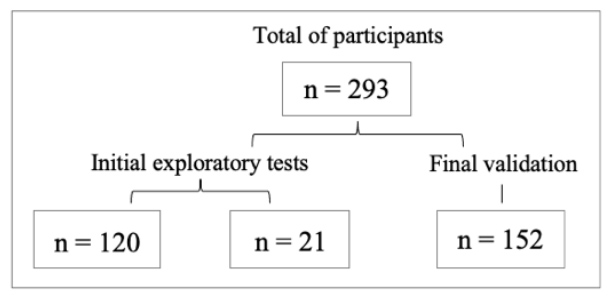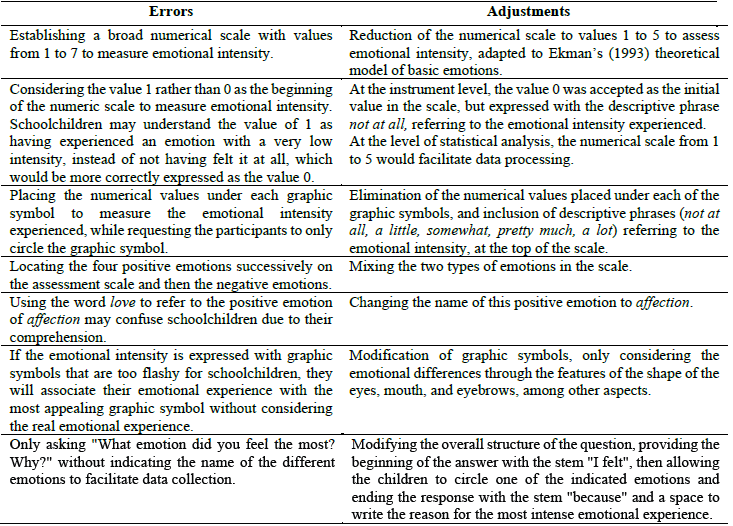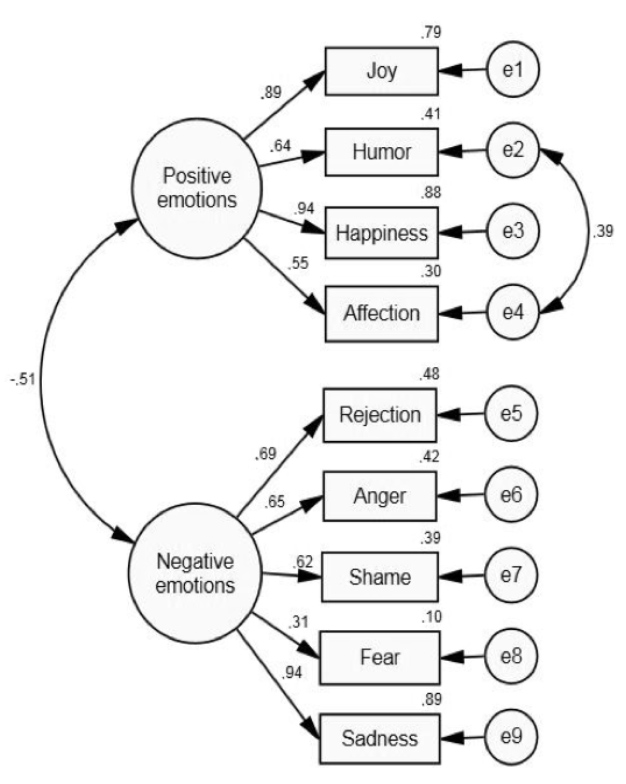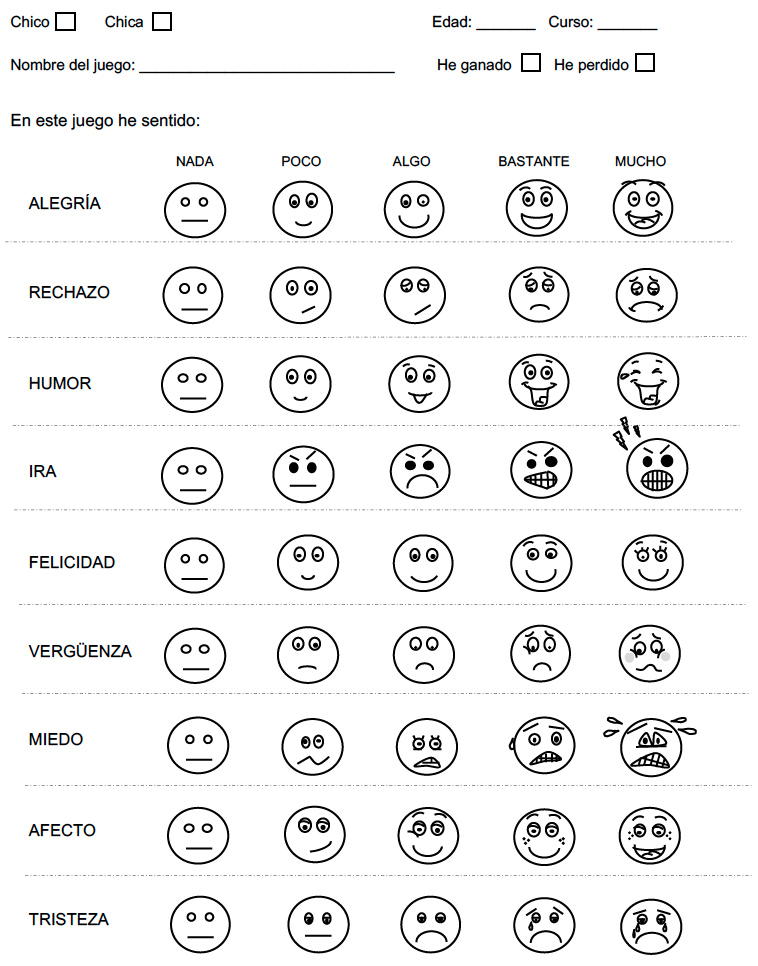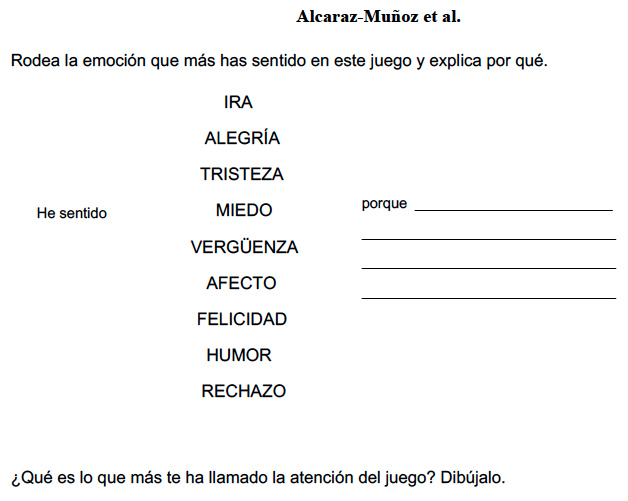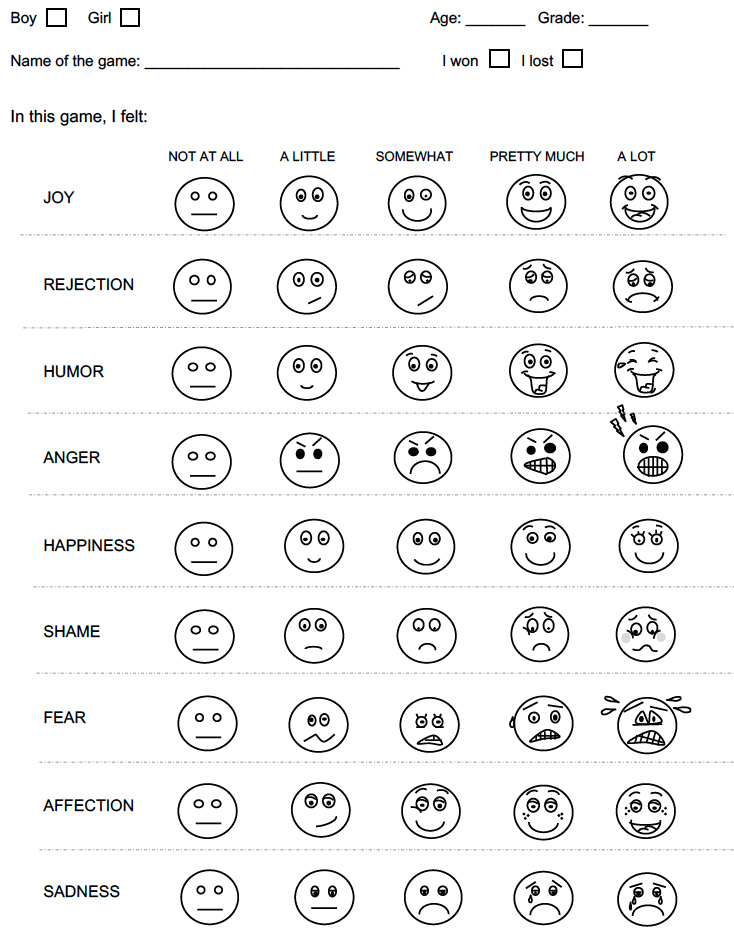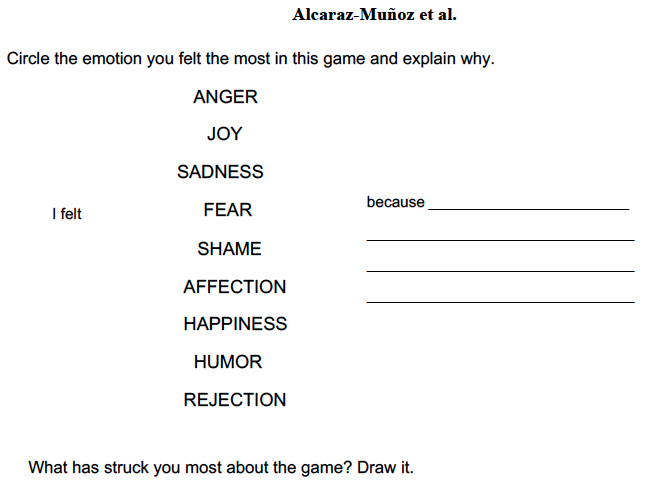INTRODUCTION
Any sports game constitutes an authentic laboratory of emotional reactions for the individual (Lavega, 2018). It is unthinkable to separate motricity from emotions; one must only stop a moment and observe situations that occur constantly in the different sport settings (Gea et al., 2016, Pic et al., 2019). Something similar happens during the practice of physical activity in the school environment, a child can feel embarrassed for having to perform a certain motor task that is not sufficiently mastered before the rest of the classmates in the class of Physical Education; can feel compassion for the classmate who falls down halfway through a race; surprise when goalkeeper stops a penalty kick, and hope for better luck in the next game or the next race.
This emotional experience may be conditioned by the local recreational and sporting culture (Etxebeste, 2009) or even social stereotypes already associated with physical activity (Chalabaev et al., 2013), which attribute, for example, greater enthusiasm for competitive practices to the male gender (Duran & Costes, 2018) or greater sensitivity to cooperative practices to the female gender (Lavega, Filella et al., 2013), some of these differences are reflected in games from an early age (Alcaraz-Muñoz et al., 2017)
The emotions that we experience determine our behaviors (Parlebas, 2018), especially when facing a situation of uncertainty, such as happens during sports or motor games (Brand & Ekkekakis, 2017; Lavega et al., 2014). The athlete showing nervousness can stop performing well in important situations such as a sprint, the player who is annoyed because of the foul may answer back or insult to the referee and thus provoke his own expulsion. The high relational and affective charge of players joins the motricity implicit in sports, motor play, and the entire range of motor practices. It is clear that emotions, regardless of whether they are aroused by favorable or unfavorable situations, play a very important role in an individual's motor intervention (Contreras & Crobu, 2018; Hongyu, 2020). The type of emotions experienced and the practice of physical activity have a direct correlation (Lane et al., 2010).
According to Lazarus (1991) and Bisquerra (2003), experienced emotions can be classified as positive (experienced in situations of well-being) or negative (experienced in situations of discomfort). Emotion should not be confused with mood, whose main difference between mood and emotion lies in the duration and intensity with which they are experienced: high intensity and short duration are characteristic of emotions, whereas mood is experienced with longer duration and lower intensity (Bisquerra, 2009; Cifo et al., 2021; Rosenberg, 1998).
With regard to the motor experiences, the motor action theory (Parlebas, 2012, 2020) differentiates four domains of motor action in accordance with the type of motor relationship between players: psychomotor (e.g. hurdle jump); cooperation (e.g. relay races), opposition (e.g. boxing) and cooperation-opposition (e.g. football). This theory encompasses the vast repertoire of motor experiences that any teacher or coach can use to develop motor skills and study its possible effects on emotions. Furthermore, these motor experiences can be performed with or without competition (final score or result). This classification covers any motor situation (sport or game) proposed in both educational and sporting contexts.
Meanwhile, to know these emotions during the practice of physical activity there are various instruments to assess emotions and physical activity, such as the Exercise Induced Feeling Inventory (EFI; Gauvin & Rejestki, 1993), the Subjective Exercise Experiences Scales (SEES; McAuley & Courneya, 1994), and the Brunel Mood Scale (BRUMS; Terry et al., 1999). Another instrument used in the practice of physical activity is the Sport Emotion Questionnaire (SEQ; Jones et al., 2005) which establishes five emotional subscales with athletes aged 19 years as well as the Discrete Emotions Questionnaire (DEQ; Harmon-Jones et al., 2016) which was designed to evaluate emotional experience in eight basic emotions.
However, these instruments present the limitation of not being specifically designed for the field of physical activity, as they follow the structure of the Profile Mood States (POMS; McNair et al., 1971), designed for clinical population, and the Positive Affect Negative Affect Schedule (PANAS; Watson et al., 1988), designed for affective states of everyday life. Furthermore, this adds another limitation to these instruments due to the confusion about emotion and mood.
According to emotions specifically, there is the instrument of Oros (2014) designed from the field of psychology for children from 8 to 12 years old. This instrument cover a group of positive emotions with 23 items that assess four dimensions (a) joy and gratitude (b) serenity (c) liking, and (d) personal satisfaction. However, besides being restricted to positive emotions, it has the disadvantage of not being specific to the area of physical activity. Given all these limitations, there is another scale that is designed for the field of physical activity linked to emotions, the Games and Emotions Scale (GES-II; Lavega-Burgués et al., 2018) which showed adequate psychometric properties for university students. This scale asses the behavior of basic emotions, according to the Bisquerra model (2000) and the consensual Biopsychological model (Tracy & Randles, 2011), in different motor experiences (Parlebas, 2012). Despite this, a common limitation for this type of instruments is that they are usually designed and validated only with a sample made up of university students (Lavega-Burgués et al., 2018). Therefore, in the present study the main objective is to design an instrument to assess the emotional experience of schoolchildren in physical education, specifically in the whole range of games or sports, which can be used by any physical activity professional. From this objective the following hypothesis is extracted: the Games and Emotions Scale for Children (GES-C) is a valid and reliable instrument to assess the emotional experience of schoolchildren in physical education, specifically in the whole range of games or sports, which can be used by any physical activity professional.
MATERIAL Y MÉTODOS
Participants
A total of 293 students of Primary Education participated in this study (see Figure 1) during their physical education classes. To validate the Games and Emotions Scale for Children (GES-C), participants were 152 students of Primary Education (72 boys and 80 girls) aged between 8 and 12 (M = 9.72, SD = 1.18), belonging to two Spanish schools (one public and one private). Participant distribution was balanced in the variables age (18.4% of 8-year-olds, 26.3% of 9-year-olds, 25.7% of 10-year-olds, 24.3% of 11-year-olds, and 5.3% of 12-year-olds) and gender (47.4% boys and 52.6% girls). The fathers, mothers, and/or legal guardians of the children gave their consent in accordance with the Declaration of Helsinki and were informed of the research process, the confidential treatment of the data, data protection compliance, and the right to leave the investigation if the participant wished to. This study was carried out in accordance with the recommendations of the University's Research Ethics Committee, who approved the protocol (ID: 1684/2017).
In the two initial exploratory tests performed with the GES-C, 120 children, aged 7-9 years, of Primary Education, and 21 children, aged 8-12 years, from two other schools in the South of Europe, also participated. Thus, a total of four schools, as well as three specialists in the area of physical education and a teacher from the area of physical activity and sports were involved in the study.
Procedure
The investigation was divided into three parts. Initially, the GES scale of Lavega, March and colleagues (2013) was adapted for primary school students and administered to 120 participants. A first exploratory analysis was performed to evaluate its content validity and comprehension. While developing this first exploratory analysis, the researcher, through direct observation, took notes of various aspects to improve the measuring instrument: (a) structure and functioning of the instrument; (b) number and type of emotions included; (c) understanding of emotional meaning; and (d) restructuring of qualitative data collection. Later, ten experts wrote field reports, highlighting the strengths and weaknesses of the instrument. In addition, a 5-level Likert scale was used, asking their level of agreement with the designed instrument, and all of them agreed by obtaining the highest value on the scale. The experts had at least five years' experience as physical education teachers (six of them). The other four were graduates in Physical Activity and Sport Sciences and experts in Sport Games and Emotions, having previously participated in research projects on the topic. The scale was then modified based on these reports, and a second exploratory analysis was performed with 21 participants of primary education to reassess the content validity and comprehension. Finally, the scale was administered to the participants selected to analyze its construct validity, internal consistency, and reliability, as well as to gather information about the participants' emotional experience in games. In each session, two games were carried out of a motor, psychomotor, cooperation, opposition and cooperation-opposition domain of action, one of these with competition and other without competition.
Initial adaptation of the instrument
The creation process was divided into two stages. In the first one, we adapted the GES (Lavega, March et al., 2013) for primary school children, considering anger, sadness, and fear as negative emotions because they are basic (Ekman, 1993); surprise as a neutral basic emotion; and as positive emotions, joy and love, the latter provided by Lazarus (1991). Unlike the GES, the number of emotions was reduced to prevent participants' fatigue when expressing their emotional experience. This selection of emotions was performed within the classification proposed by Bisquerra (2009) for educational purposes. The original scale (a Likert-type scale ranging from 0 to 10) was changed to a scale ranging from 1 (I did not feel anything) to 7 (I felt a lot). We added graphic symbols representing facial expressions based on the emotion and the emotional intensity following the contributions of DeKlerk and colleagues (2014) and Faces Scale of Wong-Baker (1988). In addition, we added a section of qualitative data where the child explained which emotion he/she had felt with greater intensity and why, along with a free choice to draw or comment, to determine whether the intensity of the emotions experienced are more closely linked to features of the internal logic or to the external logic of the game, as has been stated in various studies (Lavega et al., 2014). A first exploratory analysis was performed to obtain information about the comprehension of each item and of the validity of the scale in general.
In the second stage, the authors of the study modified the scale on the basis of the initial exploratory analysis, the researcher's notes, and the reports made by ten experts in sports games and emotions. The degree of comprehension and appropriateness of each emotion or graphic symbol of the scale were assessed in general (qualitatively), and improvements were suggested. In this sense, we added rejection and shame as negative emotions, we deleted surprise, and included humor and happiness. The emotion of love was replaced by the synonym affection, according to Bisquerra (2009). Nine emotions were selected (anger, sadness, rejection, fear, shame, joy, happiness, humor, and affection) (Bisquerra, 2009; Lazarus, 1991). The response scale was reduced to 5 points, and we included the descriptives not at all, a little, somewhat, pretty much and a lot. We also modified the graphic symbols to avoid conditioning the children's emotional experience when selecting graphic symbols with attractive features. We redesigned the qualitative data section, indicating that the children should circle the emotion experienced more intensely and justify it in a sentence that started with the stem because and they were directly requested to draw in a special section. We performed a second exploratory analysis with 21 children to obtain information about the comprehension of each item and the validity of the scale in general. Finally, the scale was composed of nine emotions distributed in two factors (positive emotions and negative emotions).
Instrument administration and data collection
The instrument was independently administered to twelve groups of primary education students, for a total of sixty 1-hour sessions, during the months of January to May. An average of 3 sessions per week were held with a time interval between sessions of 1 to 2 days. First, a session on emotional awareness and familiarization with the instrument and the dynamics of the development of the games was held. Subsequently, each group participated in four sessions corresponding to the four motor action domains, all of them in a standardized space (Parlebas, 2012), where the games were played with and without competition. At the end of each game, the children individually completed the instrument to express their emotional experience. The teacher only intervened in the sessions to explain the games, and the investigator intervened to control the dynamics of the sessions. The children did not receive any further explanation than the one appearing in the instrument itself. The instruments of children who were absent from two or more sessions, specific of the motor action domains, were discarded, as well as the incomplete instruments.
Data analysis
We proceeded to assess content validity and perform the exploratory factor analysis (EFA) and the confirmatory factor analysis (CFA). In order to carry out confirmatory factor analysis with the most appropriate estimation method, previously multivariate normality analysis was performed. Following the results of the normality test (multivariate), using the AMOS 21.0 program, we determined whether the structure yielded by the CFA presented correct fit indices, making the relevant changes. To analyze and evaluate the model, we used the maximum likelihood procedure applying the bootstrapping method, calculating the following goodness-of-fit indices (Hu & Bentler, 1999): chi square (χ2), the ratio between chi square and the degrees of freedom (χ2/df); absolute indices: the Root Mean Square Error of Approximation (RMSEA) and the Standardized Root Mean Square Residual (SRMS); and incremental fit indices: the Tucker-Lewis index (TLI), and the Comparative goodness of Fit Index (CFI).
To assess construct validity, two indexes were used: 1. Composite Reliability (CR) was regarded as acceptable with a value of > 0.7 (Heinzl et al., 2011); and 2. Average Variance Extracted (AVE), were considered appropriate for a value of 0.5 (Hair et al., 2019).
Finally, also two validity indexes were analyzed: 1. Convergent validity, considered appropriate when all the factorial loads of the non-standardized coefficients were significant (value of t >1.96) and the average factorial loads of items (AFL) for each factor was ≥ 0.7 (Hair et al., 2019); and 2. Discriminant validity, where the value of the square root of AVE of each of the factors must be greater than the correlation between those two factors (positive emotions and negative emotions) (Fornell & Cha, 1994; Hair et al., 2017).
The bivariate correlations were also analysed using Pearson's coefficients, providing descriptive data (mean and standard deviation) for each of the items.
RESULTS
Content validity
To estimate content validity, we consulted ten experts (teachers of different Spanish universities and schools), and following their suggestions, we made the corresponding adjustments (see Table 1).
Exploratory Factor Analysis (EFA)
The results of the EFA of the GES-C yielded two factors (positive emotions and negative emotions) and 9 items. Regarding construct validity, with the data of the Kaiser-Mayer-Olkin (KMO) index, with a value greater than .50 (.816), and the Bartlett (p = .000) test, we performed the EFA. We used principal components analysis and varimax rotation, obtaining two primary factors that explained 63.2% of the total variance generated by all the items of the scale. All the loadings of the items that formed the different factors were above .50. The items in the positive emotions dimension (4 items) had loadings ranging from .77 to .85, and those of the negative emotions dimension (5 items) from .51 to .81.
Confirmatory Factor Analysis (CFA)
According to Curran and colleagues (1996), who establish as limit values -2/+2 (skewness) and -7/+7 (kurtosis) to consider a normal behavior of the variables, the results of the multivariate normality indicate that, of the 9 items 5 of these do not meet the condition of skewness (values between 2.7 and 3.9) and 3 with that of kurtosis (values 7.4 and 25.2). In this line, with a value of the critical ratio (CR) of 45.799, the multivariate normality is not met, considering that those data with values > 5 are in a non-normal distribution situation (Bentler, 2005). However, different authors (Bollen & Stine, 1992; Hair et al., 2017) indicate the bootstrapping method to solve situations of low sample size and data that do not present a normal distribution, so the confirmatory factor analysis (AFC) is carried out using the Maximum Likelihood procedure by applying such bootstrapping method (Efron & Tibshirani, 1993; Hair et al., 2017).
Because the value of χ2 it is quite sensitive to sample size, the χ2/df coefficient should be taken into account (Jöreskog & Sörbom, 1993). In this regard, χ2/df values lower than 5 are accepted (Bentler, 2005). According to Hu and Bentler (1999), values of CFI, and TLI higher than .95, and values of .06 or lower for RMSEA, and of .08 for SRMR indicate a good fit of the model. However, following the consideration of Marsh and colleagues (2004) indicating that the value of .95 is an extremely limited cut-point for CFI, and TLI, values above .90 are accepted. The fit indices obtained from the first analysis matched all the established parameters except for RMSEA: χ2(26, N = 152) = 56.509, p = .000, χ2/df = 2.17, CFI = .95, TLI = .93, SRMR = .072, RMSEA = .088.
After making a re-especification in the model, the final results of the fit indices led to accepting the proposed model: χ2(25, N = 152) = 33.685, p = .115, χ2/df = 1.35, CFI = .98, TLI = .98, SRMR = .064, RMSEA = .048 (LO90 = .000 - HI90 = .086). The CFA is shown in Figure 2.
Descriptive statistics of each of the items and bivariate correlations of the observed variables are displayed in Table 2. The correlations range from r = .011 (between humor and fear) to r = .884 (between sadness and the Negative emotions factor). Nonsignificant correlations (fear with joy, humor, happiness, and affection; anger with positive emotions; and affection with shame) were also found.
Table 2. Pearson correlation coefficients of the observed variables

Note.PE= Positive emotions factor; NE= Negative emotions factor. * p < .005 (two-tailed). ** p < .001 (two-tailed).
In Table 3, the estimated parameters of the confirmatory factor analysis are displayed, and in addition, the completely standardized solution is also shown in Figure 2.
Table 3. Fully standardized estimators and non-standardized, standard error, critical proportion and statistical significance

Note.S. Estimate= Standardized value; Estimate= Non-standardized value; SE= Standard error; CP= Critical proportion; p= Statistical significance.*** p < .001
As Table 4 reports, the composite reliability (CR) is confirmed and an acceptable value of the average variance extracted (AVE) in both factors which, although in the factor “negative emotions” show 0.05 points below the value considered valid (0.5), this difference should not be considered as serious (significant).
Table 4. Reliability and validity of the model

Note.CR= Composite reliability; AFL= Average factorial loads of items; AVE= Average Variance Extracted; *= Square Root Average Variance Extracted.
Regarding the values of the average factorial loads of items (AFL) in each of the constructs (see Table 4) and the values of non-standardized factor loads (values of t > 1.96, see Table 3), the existence of convergent validity is confirmed; it also has to be considered that the value of AFL of the factor negative emotions (0.64) is slightly below 0.7 (considered as optimal); however, this difference is minimal.
Finally, the values of the correlations provided in Table 4 (data of the square root of the AVE of each factor: 0.77 and 0.67, higher than the correlation between both constructs: -0.51), confirm the existence of discriminant validity.
DISCUSSION
The main goal was to design an instrument to assess the emotional experience of schoolchildren in physical education, specifically in the whole range of games or sports, which can be used by any physical activity professional.
The results of this study suggest that the GES-C is a structurally valid and reliable instrument to measure emotional intensity of four positive emotions and five negative emotions in school children aged 8 to 12 when practicing games or sports with or without competition, both in an educational and sports context. It also presents the experts' guarantee of content validity.
The GES-C provides a scale with a reduced number of emotions (positive and negative) in contrast to the GES (Lavega, March et al., 2013), but following the model of Bisquerra (2009) and Lazarus (1991). Graphic symbols have been added to facilitate the assessment of emotional intensity for children aged 8 to 12 years, and the Likert-type scale assessment has been modified. In addition, qualitative data are collected through subjective comments and drawings.
The CFA of the nine items and two factors was significant with χ2/df values lower than 5 (Bentler, 2005). Other relevant indices CFI, and TLI with values higher than .95, values lower than .06 for the RMSEA, and lower than .08 for the SRMR, suggest that the fit of the two-factor model is satisfactory (Hu & Bentler, 1999). These data were closer to the optimum value than those obtained in the study of Lavega, March and colleagues (2013) performed with the original GES scale in university students.
The content validity confirmed that the structure of the GES-C, based on the theoretical framework of motor praxeology (Parlebas, 2012) and of emotions (Bisquerra, 2009; Lazarus, 1991) is suitable to analyze the emotions aroused by sports games. This scale provides great pedagogical support for physical education teachers.
In relation to the values obtained in emotional intensity, the results showed a higher intensity of positive than of negative emotions when participating in games of different motor action domains, as in other studies with college students (Lavega et al., 2014), secondary education students (Duran & Costes, 2018), and primary education students (Miralles et al., 2017). In this sense, games are presented as a suitable means to reinforce the person's formation, encouraging a positive emotional climate (Desivilya & Yagil, 2005; Duran & Costes, 2018).
From the present study, we observe the need to continue analyzing the broad range of positive emotions. Following the contributions of Harmon-Jones and colleagues (2016), who stated that positive emotions are the least evaluated, both clinically and psychologically, despite their great relevance. Also from a pedagogical point of view, Oros (2014) proposed analysing the behaviour of positive emotions, such as affection and humour, especially with schoolchildren. Moreover, Edwards (2006) and Lavega and colleagues (2014) affirm that any motor behavior not only reveals the players' strictly physical involvement, it also shows the personal experience that accompanies it, their happiness, their fears, or perceptions. Emotions are key in the formation of motor behaviour, as the individual's emotional behaviour shapes his or her cognitive structure (decision-making), social relations and motor actions (Parlebas, 2012).
On the other hand, the behaviour of the negative emotions corresponded to that expected, including the fear variable. As was the case in Lavega-Burgués and colleagues (2018), the distribution of the emotion fear was asymmetrically positive, and as already indicated, perhaps because this emotion was hardly activated by the sports games.
In conclusion, this study presents a valid and reliable instrument to specifically determine the emotional intensity experienced by primary school students in four positive emotions (joy, happiness, affection, and humor) and five negative emotions (sadness, anger, shame, fear, and rejection) when practicing games of different domains: psychomotor, cooperation, opposition or cooperation-opposition, with or without competition. Therefore, this instrument can be applied in both educational and sport contexts. However, it is necessary to continue to apply it in further research to reaffirm the validity and reliability of the GES-C.
The limitation of this study is that the sample was composed of Spanish primary school students in physical education. It would be convenient to carry out this study with students from other cultures to ratify these findings.
PRACTICAL APPLICATIONS
The results of this study provide teachers, instructors and coaches of physical education or sports with a valid and reliable instrument to find out about the emotional experience generated by their motor practices in children from 8 to 12 years old.
Until now, scales designed on a clinical basis have been used to assess moods and not emotions, or scales designed in the physical activity setting to assess emotions, but validated with an adult sample. This study has been designed and validated an instrument to assess the intensity of positive and negative emotions in a variety of motor situations, with or without competition, to be applied in both educational and sporting contexts with schoolchildren.
Teachers or physical education professionals are encouraged to use this instrument to learn about emotional experiences of their players, and thus propose motor situations that generate a positive and motivating learning climate in accordance with their pedagogical objectives.













